Legacy Reissues : Summer 2005
by Scott Hreha
12 September 2005
In an unusually busy summer for the jazz reissue division at Columbia Legacy, several of the label’s more obscure gems have been returned to circulation after only having been available as Japanese imports, if at all. It’s a smart move for the label to issue these titles in the midst of a heavy onslaught of novice-oriented collections—“Essential” overviews of big band era giants like Duke Ellington, Glenn Miller, Artie Shaw, and Tito Puente and further entries to the “Jazz Moods” series by artists ranging from Louis Armstrong to Stanley Turrentine to Esther Phillips have threatened to dominate the jazz consumer interest this season, so these discs come as a welcome relief for the music’s more discerning listeners. In addition to a “Legacy Edition” of Miles Davis’ ‘Round About Midnight, classic sessions by Ahmad Jamal, Horace Silver, Art Blakey, Gerry Mulligan, Bob Brookmeyer, Dexter Gordon, and Woody Shaw are all now available, featuring updated liner notes—from the artists themselves where possible—and, in all but two cases, generous helpings of previously unreleased bonus material. 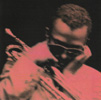 ‘Round About Midnight holds special historical weight as Miles’ debut for Columbia; featuring the same quintet that defected from Prestige—John Coltrane (tenor sax), Red Garland (piano), Paul Chambers (bass), and Philly Joe Jones (drums)—it represents the beginning of one of the longest artist-label relationships in the history of recorded music. It’s a fact the label is all too well aware of, judging by the frequency with which a lot of this material has been reconfigured and repackaged; a case in point being that the first disc of this Legacy Edition is identical to the 2001 single-disc reissue, containing the original six-track LP with four additional pieces from the same session. What’s bound to get collectors and purists excited, however, is the second disc of the set: a previously unreleased 32-minute live performance from February 1956 featuring the same quintet, complete and unedited. With pristine sound quality and exemplary performances by both Davis and Coltrane, it’s difficult not to recommend a trade-up for fans of either man’s work. ‘Round About Midnight holds special historical weight as Miles’ debut for Columbia; featuring the same quintet that defected from Prestige—John Coltrane (tenor sax), Red Garland (piano), Paul Chambers (bass), and Philly Joe Jones (drums)—it represents the beginning of one of the longest artist-label relationships in the history of recorded music. It’s a fact the label is all too well aware of, judging by the frequency with which a lot of this material has been reconfigured and repackaged; a case in point being that the first disc of this Legacy Edition is identical to the 2001 single-disc reissue, containing the original six-track LP with four additional pieces from the same session. What’s bound to get collectors and purists excited, however, is the second disc of the set: a previously unreleased 32-minute live performance from February 1956 featuring the same quintet, complete and unedited. With pristine sound quality and exemplary performances by both Davis and Coltrane, it’s difficult not to recommend a trade-up for fans of either man’s work.
Recorded in Chicago in 1951-1952 and New York in 1955, Ahmad Jamal’s The Complete Legendary OKEH and Epic Recordings capture the Pittsburgh-born pianist in the years before his ascent to widespread popularity. Jamal’s music here owes much to the Nat King Cole-inspired trio format of piano, guitar (played by Ray Crawford), and bass (Eddie Calhoun on the Chicago sessions, Israel Crosby in New York), serving up blues-drenched renditions of standards like “The Surrey with the Fringe on Top”, “Autumn Leaves”, and “They Can’t Take That Away from Me”. But not everything is by the numbers: Crawford adds some inventive plectral percussion on several tracks, including a stretched-out version of “Love for Sale” that simmers with after-hours cool. 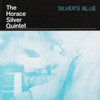 The 1956 sessions that produced Horace Silver’s Silver’s Blue came during something of a transitional period for the pianist, as he was ending his membership in Art Blakey’s Jazz Messengers and about to embark on his own recording career for Blue Note. As such, the performances are stronger than generally associated with contract-fulfilling LPs, a situation Silver explains at length in his personal section of the liner notes. The record offers an early blueprint of what Silver would perfect for his new label later in the decade—a well-rounded combination of sultry blues, standards, and driving hard bop—played with grit and soul by Donald Byrd (trumpet), Hank Mobley (tenor sax), Doug Watkins (bass), and Art Taylor (drums). Joe Gordon (trumpet) and Kenny Clarke (drums) sit in for Byrd and Taylor on two of the record’s strongest uptempo bop performances, “To Beat or Not to Beat” and “Shoutin’ Out”—it’s a rare treat to hear Klook pushing Silver and Mobley to their hottest solos on the LP. The 1956 sessions that produced Horace Silver’s Silver’s Blue came during something of a transitional period for the pianist, as he was ending his membership in Art Blakey’s Jazz Messengers and about to embark on his own recording career for Blue Note. As such, the performances are stronger than generally associated with contract-fulfilling LPs, a situation Silver explains at length in his personal section of the liner notes. The record offers an early blueprint of what Silver would perfect for his new label later in the decade—a well-rounded combination of sultry blues, standards, and driving hard bop—played with grit and soul by Donald Byrd (trumpet), Hank Mobley (tenor sax), Doug Watkins (bass), and Art Taylor (drums). Joe Gordon (trumpet) and Kenny Clarke (drums) sit in for Byrd and Taylor on two of the record’s strongest uptempo bop performances, “To Beat or Not to Beat” and “Shoutin’ Out”—it’s a rare treat to hear Klook pushing Silver and Mobley to their hottest solos on the LP.
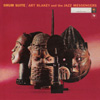 Later that same year, Blakey himself was moving ahead with a revamped lineup for his Jazz Messengers group and looking at innovative new musical avenues. Drum Suite, Blakey’s second LP for Columbia, splits the two directions over an LP side each, with one given to leftover tracks from the first Jazz Messengers session for the label and the other to a percussion ensemble featuring Jo Jones, Specs Wright, Candido Camero, and Sabu Martinez. Assisted by pianist Ray Bryant and bassist Oscar Pettiford—who both contribute a composition to the ensemble as well—Blakey’s percussive experiment mixes African and Latin rhythms to exhilarating effect, laying the groundwork for similar ventures by Olatunji and Max Roach. The edition of the Jazz Messengers documented here—Bill Hardman (trumpet), Jackie McLean (alto sax), Sam Dockery (piano), and Spanky DeBrest (bass)—might be one of the group’s lesser-known incarnations, but is nowhere near inferior, as McLean’s solo on “Nica’s Tempo” announces with certainty. The reissue also adds three bonus tracks by yet another Messengers group, as Donald Byrd (trumpet), Ira Sullivan (doubling on trumpet and tenor sax), Kenny Drew (piano), and Wilbur Ware (bass) join Blakey for three takes on Byrd’s composition “The New Message”. Later that same year, Blakey himself was moving ahead with a revamped lineup for his Jazz Messengers group and looking at innovative new musical avenues. Drum Suite, Blakey’s second LP for Columbia, splits the two directions over an LP side each, with one given to leftover tracks from the first Jazz Messengers session for the label and the other to a percussion ensemble featuring Jo Jones, Specs Wright, Candido Camero, and Sabu Martinez. Assisted by pianist Ray Bryant and bassist Oscar Pettiford—who both contribute a composition to the ensemble as well—Blakey’s percussive experiment mixes African and Latin rhythms to exhilarating effect, laying the groundwork for similar ventures by Olatunji and Max Roach. The edition of the Jazz Messengers documented here—Bill Hardman (trumpet), Jackie McLean (alto sax), Sam Dockery (piano), and Spanky DeBrest (bass)—might be one of the group’s lesser-known incarnations, but is nowhere near inferior, as McLean’s solo on “Nica’s Tempo” announces with certainty. The reissue also adds three bonus tracks by yet another Messengers group, as Donald Byrd (trumpet), Ira Sullivan (doubling on trumpet and tenor sax), Kenny Drew (piano), and Wilbur Ware (bass) join Blakey for three takes on Byrd’s composition “The New Message”.
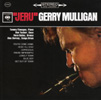 Gerry Mulligan’s Jeru, recorded in 1962, is somewhat of an anomaly in the baritone saxophonist’s discography. Previous to this session, Mulligan’s sole small group recording with a piano player was an “all-star” meeting with Thelonious Monk, cut for Riverside in 1957. The pianist in question here is Tommy Flanagan, whose laid-back style fits well on this set of mostly midtempo ballads and bossa novas, which include two pieces by Billy Taylor—“Capricious” and “Inside Impromptu”—as well as a Mulligan original, “Blue Boy”. The group is rounded out by bassist Ben Tucker, Alec Dorsey on congas, and drummer Dave Bailey—who originally planned to release the LP on his own Jazzline label until Columbia intervened with “an offer [they] couldn’t refuse”. Due to the similarity in moods throughout the session, it’s probably the least thrilling of the batch; still, fans of Mulligan’s work won’t want to pass up a unique opportunity to hear him navigate Flanagan’s harmonic frameworks. Gerry Mulligan’s Jeru, recorded in 1962, is somewhat of an anomaly in the baritone saxophonist’s discography. Previous to this session, Mulligan’s sole small group recording with a piano player was an “all-star” meeting with Thelonious Monk, cut for Riverside in 1957. The pianist in question here is Tommy Flanagan, whose laid-back style fits well on this set of mostly midtempo ballads and bossa novas, which include two pieces by Billy Taylor—“Capricious” and “Inside Impromptu”—as well as a Mulligan original, “Blue Boy”. The group is rounded out by bassist Ben Tucker, Alec Dorsey on congas, and drummer Dave Bailey—who originally planned to release the LP on his own Jazzline label until Columbia intervened with “an offer [they] couldn’t refuse”. Due to the similarity in moods throughout the session, it’s probably the least thrilling of the batch; still, fans of Mulligan’s work won’t want to pass up a unique opportunity to hear him navigate Flanagan’s harmonic frameworks.
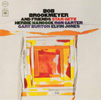 Between Bob Brookmeyer’s unconventional instrument of choice—the valve trombone—and the dumbfounding collection of musicians assembled for Bob Brookmeyer & Friends, the LP leaves very little room for middle ground; according to vibraphonist Gary Burton’s liner notes, the success of the finished product came as a surprise to most everyone involved. In May 1964, Brookmeyer called together a group consisting of old friend Stan Getz (tenor sax), Herbie Hancock (piano), Ron Carter (bass), Elvin Jones (drums), and a 21-year-old Burton to record an LP’s worth of original compositions with producer du jour Teo Macero. Due to some conceptual differences between Macero and the leader, the LP became an even mix of originals and Brookmeyer-arranged standards, but that doesn’t dilute the brilliance of the recorded results. All egos are set aside in the interest of loose, spontaneous energy, whether on vampy Brookmeyer pieces like “Jive Hoot” and “The Wrinkle” or clever recastings of chestnuts like “Misty” and “I’ve Grown Accustomed to Her Face”. The CD reissue adds three previously unreleased tracks, including a version of the Strayhorn/Ellington ballad “Day Dream” with Tony Bennett on vocals—topping off one of the year’s most prized rediscoveries. Between Bob Brookmeyer’s unconventional instrument of choice—the valve trombone—and the dumbfounding collection of musicians assembled for Bob Brookmeyer & Friends, the LP leaves very little room for middle ground; according to vibraphonist Gary Burton’s liner notes, the success of the finished product came as a surprise to most everyone involved. In May 1964, Brookmeyer called together a group consisting of old friend Stan Getz (tenor sax), Herbie Hancock (piano), Ron Carter (bass), Elvin Jones (drums), and a 21-year-old Burton to record an LP’s worth of original compositions with producer du jour Teo Macero. Due to some conceptual differences between Macero and the leader, the LP became an even mix of originals and Brookmeyer-arranged standards, but that doesn’t dilute the brilliance of the recorded results. All egos are set aside in the interest of loose, spontaneous energy, whether on vampy Brookmeyer pieces like “Jive Hoot” and “The Wrinkle” or clever recastings of chestnuts like “Misty” and “I’ve Grown Accustomed to Her Face”. The CD reissue adds three previously unreleased tracks, including a version of the Strayhorn/Ellington ballad “Day Dream” with Tony Bennett on vocals—topping off one of the year’s most prized rediscoveries.
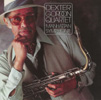 Dexter Gordon’s homecoming to New York City in 1976 is one of the most triumphant tales in jazz history, due in no small part to the fact that Gordon’s playing was better than it had been in his entire career, even after 14 years of “exile” in Europe. Columbia was there to document those homecoming gigs at the Village Vanguard, but Manhattan Symphonie—recorded two years later in 1978 with his then-working quartet of George Cables (piano), Rufus Reid (bass), and Eddie Gladden (drums)—ranks right up there among the classic works in the tenor saxophonist’s ample discography. Gordon wasn’t a prolific composer, but he had an unparalleled way of breathing life into even the most mundane standards that’s in full evidence on this reissue—see “Body and Soul” for a perfect example. The rest of the disc combines ballads with uptempo bop tunes like John Coltrane’s “Moment’s Notice”, with the quartet proving throughout that it’s not necessary to throw chord changes out the window to achieve telepathic jazz communication. Most artists are lucky to have even one span of boundless creativity over the course of their careers; that Dexter Gordon enjoyed three is a testament to the true depths of his genius, a status that Manhattan Symphonie further edifies. Dexter Gordon’s homecoming to New York City in 1976 is one of the most triumphant tales in jazz history, due in no small part to the fact that Gordon’s playing was better than it had been in his entire career, even after 14 years of “exile” in Europe. Columbia was there to document those homecoming gigs at the Village Vanguard, but Manhattan Symphonie—recorded two years later in 1978 with his then-working quartet of George Cables (piano), Rufus Reid (bass), and Eddie Gladden (drums)—ranks right up there among the classic works in the tenor saxophonist’s ample discography. Gordon wasn’t a prolific composer, but he had an unparalleled way of breathing life into even the most mundane standards that’s in full evidence on this reissue—see “Body and Soul” for a perfect example. The rest of the disc combines ballads with uptempo bop tunes like John Coltrane’s “Moment’s Notice”, with the quartet proving throughout that it’s not necessary to throw chord changes out the window to achieve telepathic jazz communication. Most artists are lucky to have even one span of boundless creativity over the course of their careers; that Dexter Gordon enjoyed three is a testament to the true depths of his genius, a status that Manhattan Symphonie further edifies.
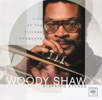 Trumpeter Woody Shaw was a major player in Dexter Gordon’s homecoming gigs at the Village Vanguard, which were released by Columbia as a double-LP to anoint Gordon’s return to the U.S.; two years later Shaw returned to the scene of the crime with his own quintet and recorded an equally stunning document, Stepping Stones—chronologically the last reissue in this batch. Shaw leads the group on cornet and flugelhorn—no trumpet—through a set of lengthy originals and McCoy Tyner’s “Blues for Ball” with plenty of fire and passion to go around. Tenor and soprano saxophonist Carter Jefferson nearly steals the show—his interplay with Shaw on the title track is worth the sticker price alone—although pianist Onaje Allan Gumbs, bassist Clint Houston, and drummer Victor Lewis all add incomparable solo work, as well as compositions to the quintet’s repertoire. Shaw cut several excellent records as a leader for Contemporary, Muse, and Columbia before his tragic death in 1989, but Stepping Stones stands out as one of his finest for the level of empathy among the band members. Trumpeter Woody Shaw was a major player in Dexter Gordon’s homecoming gigs at the Village Vanguard, which were released by Columbia as a double-LP to anoint Gordon’s return to the U.S.; two years later Shaw returned to the scene of the crime with his own quintet and recorded an equally stunning document, Stepping Stones—chronologically the last reissue in this batch. Shaw leads the group on cornet and flugelhorn—no trumpet—through a set of lengthy originals and McCoy Tyner’s “Blues for Ball” with plenty of fire and passion to go around. Tenor and soprano saxophonist Carter Jefferson nearly steals the show—his interplay with Shaw on the title track is worth the sticker price alone—although pianist Onaje Allan Gumbs, bassist Clint Houston, and drummer Victor Lewis all add incomparable solo work, as well as compositions to the quintet’s repertoire. Shaw cut several excellent records as a leader for Contemporary, Muse, and Columbia before his tragic death in 1989, but Stepping Stones stands out as one of his finest for the level of empathy among the band members.
|

